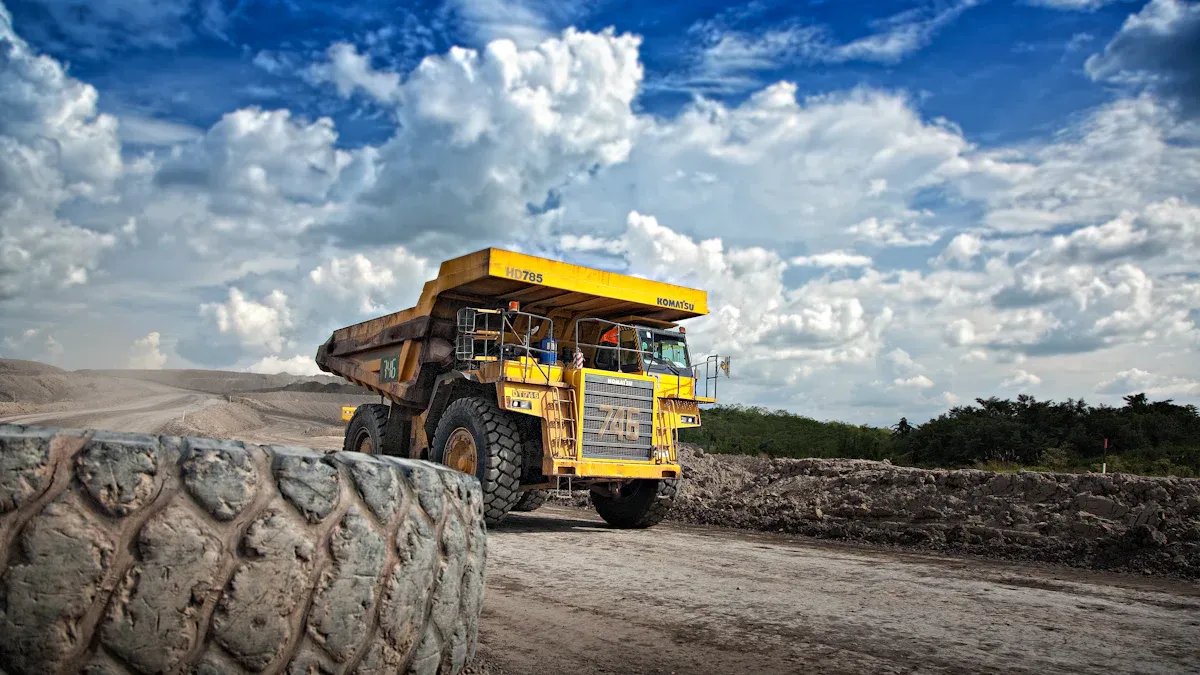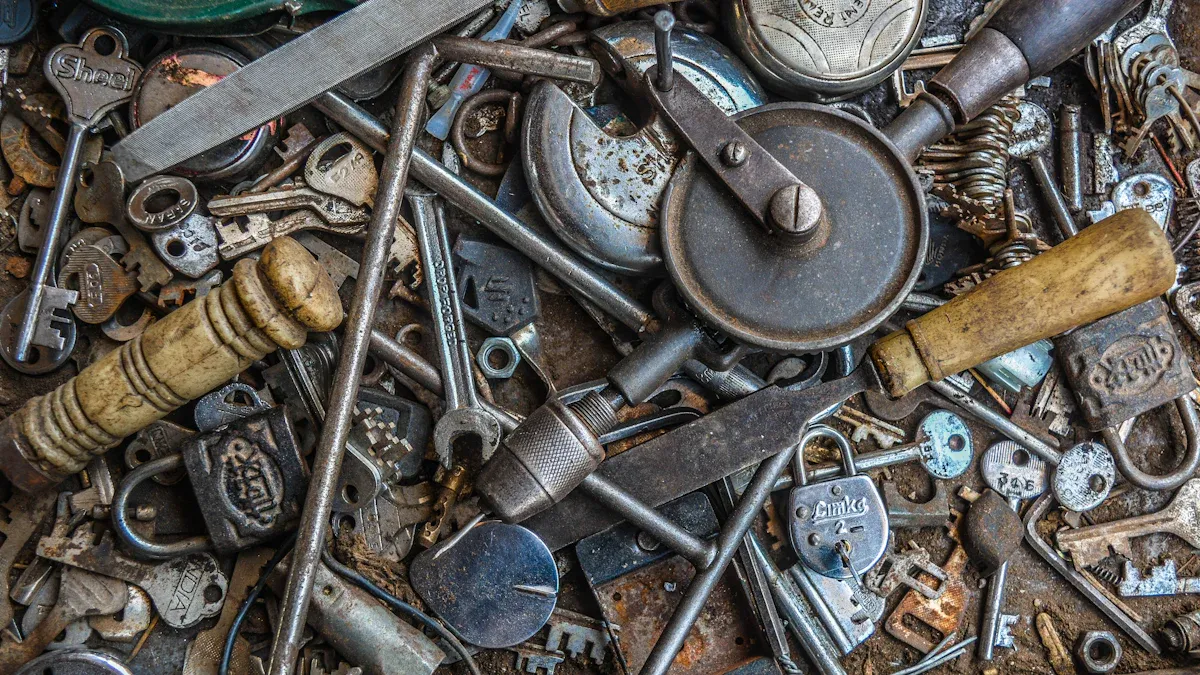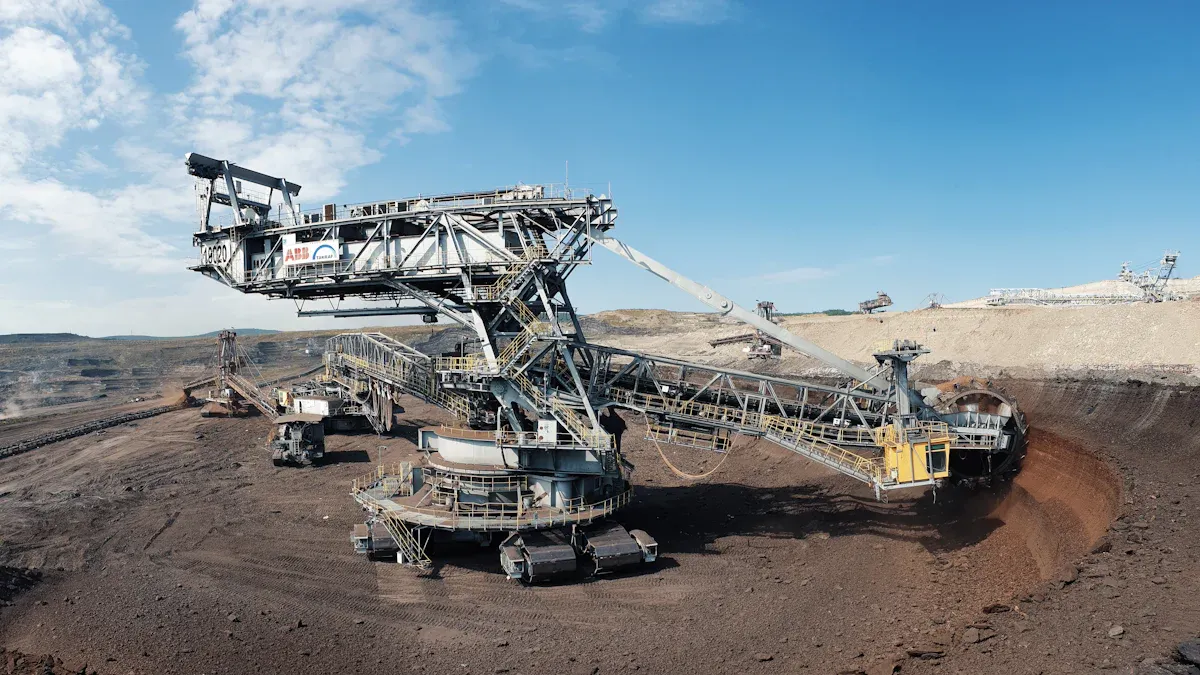
Mining operations demand durability and efficiency. Equipment faces constant stress from harsh conditions, leading to wear and tear. Mining wear parts play a critical role in combating this. These specialized components can extend equipment lifespan by up to 30%. They also reduce annual maintenance costs by 20%. Companies using premium materials experience 30% less downtime compared to those relying on cheaper alternatives. Preventive maintenance, combined with high-quality wear parts, can further enhance equipment life by 25%. By investing in these parts, you ensure smoother operations and greater productivity.
Mining wear parts are specialized components designed to protect mining equipment from damage caused by abrasive materials, impact, and extreme conditions. These parts include items like wear plates, liners, grates, and urethane components. Each serves a specif ic purpose, such as shielding surfaces, facilitating material sorting, or enhancing equipment durability.
Historically, the evolution of mining wear parts technology has transformed mining operations. For example:
| Time Period | Key Developments | Impact on Technology |
|---|---|---|
| Early Civilizations | Use of mortar and pestle for manual ore crushing. | Laid the foundation for future advancements in crushing technology. |
| Roman Era | Development of stamp mills using water wheels for mechanical crushing. | Significantly improved productivity in ore processing. |
| 18th-19th Century | Introduction of mechanized crushers (jaw and roll crushers). | Drastically improved efficiency and reduced manual labor. |
| 1858 | Invention of the Blake Jaw Crusher. | Revolutionized the mining industry with consistent and powerful crushing capabilities. |
| Early 20th Century | Introduction of cone and impact crushers. | Improved crushing efficiency and allowed for finer output sizes. |
| 1980s | Development of high-pressure grinding rolls (HPGR). | Provided energy-efficient alternatives, reducing energy consumption. |
| Modern Era | Integration of automation and digital control systems. | Optimized performance and reduced downtime through predictive maintenance. |
These advancements highlight the importance of wear parts in mining equipment.
Mining wear parts play a vital role in protecting core infrastructure across various applications. They safeguard conveyor belts, transfer chutes, mobile machinery, and ground engagement tools. By reducing wear and tear, these parts enhance equipment performance and extend its lifespan.
Wear parts are a critical component in the overall mining process. Their performance directly impacts profitability and efficiency. Reputable suppliers test products under real-world mining conditions to ensure optimal material specification, geometry, heat treatment, and coatings.
Case studies further illustrate their importance. At the Milpillas copper mine, optimized wear parts increased safety and reduced downtime. The lifetime of concave segments for the primary gyratory crusher improved from 6 months to 2 years, boosting equipment availability. Screening media change-outs dropped to a third, enhancing operational efficiency.
Heavy-duty mining operations demand robust solutions to withstand extreme conditions. Mining wear parts fulfill this need by offering durability and reliability. For example:
Wear Plates: Protect machinery surfaces from abrasive materials and impact.
Liners: Shield interior surfaces, improving efficiency and minimizing downtime.
Grates: Facilitate material sorting and screening, designed to endure high-impact forces.
Urethane Parts: Provide adaptable wear solutions with excellent resistance.
By using high-quality wear parts, you can reduce equipment failure, lower maintenance costs, and ensure uninterrupted operations. These components are indispensable for maintaining productivity in demanding environments.
Mining equipment operates in harsh environments, facing constant exposure to abrasive materials and heavy impacts. Using mining wear parts significantly enhances the durability of your machinery. These parts are designed to withstand extreme conditions, reducing the wear rate and extending the lifespan of critical components.
For example, studies show that identifying defective subassemblies and replacing them with high-quality wear parts can improve equipment longevity. The table below highlights key findings related to durability:
| Findings | Description |
|---|---|
| Wear Rate | Increased wear rates in mining machines indicate the need for durable parts. |
| Reliability Assessment | Improved parts enhance the operational reliability of equipment. |
| Failure Causes | Addressing defective subassemblies boosts equipment longevity. |
Reliability metrics also demonstrate how wear parts improve durability:
- Equipment uptime vs. downtime
- Mean time to repair (MTTR)
- Mean time between failures (MTBF)
- Maintenance costs as a percentage of replacement asset value (RAV)
- Overall equipment effectiveness (OEE)
By investing in durable mining wear parts, you can reduce the frequency of repairs and ensure your equipment remains operational for longer periods.
Frequent maintenance can drain resources and disrupt operations. Mining wear parts help you minimize these costs by reducing the need for constant repairs. High-quality wear parts are engineered to resist damage, which means fewer replacements and less downtime.
Preventive maintenance becomes more effective when you use durable components. For instance, wear parts designed for specific applications can predict wear trends, allowing you to schedule maintenance before failures occur. This proactive approach reduces unnecessary repairs and lowers overall maintenance expenses.
Additionally, companies that prioritize premium wear parts often experience a significant drop in maintenance costs as a percentage of their replacement asset value. This not only saves money but also ensures smoother operations.
Operational efficiency is crucial in mining, where downtime can lead to significant losses. Mining wear parts play a vital role in keeping your equipment running smoothly. They reduce the likelihood of unexpected failures, allowing you to maintain consistent production rates.
The table below outlines measurable improvements in efficiency linked to wear parts:
| Benefit | Description |
|---|---|
| Real-time monitoring | Enables accurate data collection on equipment wear, improving monitoring precision. |
| Preventive maintenance | Predicts wear trends, reducing downtime by addressing issues before they escalate. |
| Improved production efficiency | Minimizes downtime, leading to higher overall production rates. |
| Reduced maintenance costs | Focused maintenance lowers unnecessary repairs, saving time and money. |
By incorporating high-quality mining wear parts into your operations, you can achieve better production efficiency and reduce downtime. This ensures that your equipment operates at peak performance, maximizing output and profitability.
Investing in high-quality mining wear parts offers significant long-term cost savings for your operations. While the initial expense may seem higher, the benefits far outweigh the costs over time. These parts are designed to last longer, reducing the frequency of replacements and repairs. This durability directly translates into lower operational expenses.
One of the key ways mining wear parts save money is by minimizing downtime. Equipment failures can halt production, leading to lost revenue. By using wear parts that resist damage and wear, you can keep your machinery running smoothly for extended periods. This ensures consistent productivity and prevents unexpected costs associated with emergency repairs.
Another advantage lies in energy efficiency. Worn-out components often require more energy to operate, increasing fuel or electricity consumption. High-quality wear parts maintain opt imal performance, reducing energy usage and lowering utility bills. Over time, these savings can add up significantly.
Tip: Track your maintenance and energy costs before and after upgrading to premium wear parts. This will help you quantify the financial benefits and justify the investment.
Additionally, using durable wear parts reduces the strain on other components. For example, a well-maintained liner can protect the structural integrity of your equipment, preventing costly damage to critical systems. This holistic approach to equipment care ensures that your machinery operates efficiently and lasts longer.
Finally, long-term cost savings also come from improved safety. Equipment failures can pose risks to workers and lead to expensive liability claims. Reliable wear parts reduce the likelihood of accidents, protecting both your team and your bottom line.
By prioritizing high-quality mining wear parts, you can achieve substantial savings over the lifespan of your equipment. This investment not only reduces costs but also enhances the overall efficiency and safety of your operations.

Mining wear parts come in various forms, each designed to handle specific tasks and conditions. Some of the most common types include:
Buckets: Essential for excavators and loaders, buckets handle materials like soil, rock, and ore. Their design focuses on durability and capacity.
Liners: These protect the interior surfaces of equipment like crushers and chutes from abrasion and impact. Liners extend the lifespan of machinery by reducing wear.
Teeth: Found on buckets and other digging tools, teeth improve penetration and material handling.
Different types of teeth serve unique purposes:
- Chisel Teeth: Ideal for general digging and trenching in loose soil.<
br />
- Rock Chisel Teeth: Built for hard, rocky terrain.
- Single Tiger Teeth: Sharp and effective for compact soil and rock.
- Twin Tiger Teeth: Provide double penetration power for extremely hard surfaces.
- Specialized Teeth: Includes conical, serrated, and flared designs for specific applications.
Note: A study on bucket teeth revealed that wear mechanisms like abrasion and adhesion are the primary causes of damage. Advanced materials, such as austenitic steel, improve resistance and extend service life.
Mining wear parts play a critical role in various types of equipment. Each application demands specific materials and designs to maximize performance:
| Equipment Type | Material Used | Performance Improvement | Maintenance Impact |
|---|---|---|---|
| Crushers | Nickel-based alloys | 40% longer operational life of slurry pump | Reduced downtime and maintenance costs |
| Conveyors | HCWI or ceramic-reinforced | 50% reduction in maintenance time | Continuous production without shutdowns |
| Excavators | Manganese steel | 30-40% extended maintenance intervals | Lower operating costs and improved reliability |
Crushers: Wear parts like liners and grates protect against the constant impact and abrasion of crushing hard materials.
Excavators: Buckets and teeth enhance digging efficiency and reduce stress on the machine.
Conveyors: Liners and wear plates ensure smooth material transport, minimizing interruptions.
By selecting the right wear parts for each application, you can improve equipment performance and reduce maintenance needs.
The material composition of mining wear parts directly affects their durability and efficiency. Advanced materials like composite alloys and reinforced ceramics offer superior resistance to wear and impact.
This study investigates the performance of composite alloy wear parts in mining, emphasizing how a homogeneous microstructure with fine, non-interconnected carbides enhances abrasion resistance and impact toughness.
The research correlates the microstructure and chemical composition of white cast iron alloys with their wear resistance and fracture toughness, indicating that the eutectic carbide phase significantly influences wear performance.
Iron-based hardfacing alloys are another example of materials designed for mining wear parts. These alloys resist abrasive and impact wear, making them ideal for demanding environments. Modifications like surface treatments and coatings further enhance their performance.
This work explores how the abrasion-induced martensitic transformation in iron-base diamond-impregnated composites affects their wear behavior, revealing that unstable austenite contributes to increased abrasion resistance.
Choosing the right material for your wear parts ensures better performance, longer service life, and reduced operational costs.
Selecting high-quality mining wear parts requires careful evaluation of several factors. You need to prioritize durability, compatibility, and material composition to ensure optimal performance. Here are some key criteria to guide your decision:
Sustainability: Wear parts that last longer reduce changeouts and support sustainable mining practices.
Operational Efficiency: Components designed for specific tasks improve productivity and minimize downtime.
Certifications: Look for manufacturers with certifications verifying adherence to industry standards like ISO.
Material Strength: High-strength alloys and advanced coatings enhance wear resistance in abrasive environments.
Customization: Tailored solutions ensure compatibility with your equipment and operational needs.
For a more detailed breakdown, consider these technical specifications:
| Key Factor | Description |
|---|---|
| Material Composition | High-strength alloys and advanced coatings enhance durability. |
| Manufacturing Process | Precision engineering and strict quality control improve performance. |
| Wear Resistance | Heat-treated and reinforced materials last longer in abrasive environments. |
By focusing on these factors, you can select wear parts that meet your operational demands and extend equipment life.
Partnering with trusted suppliers ensures you receive reliable and high-performing wear parts. Reputable suppliers adhere to strict quality standards and provide comprehensive support. Here’s what to look for:
Certifications and Standards: Suppliers with ISO certifications demonstrate commitment to quality.
Proven Track Record: Manufacturers with extensive experience in mining deliver dependable products.
After-Sales Support: Warranty coverage, technical assistance, and part availability ensure smooth operations.
Additionally, trusted suppliers maintain quality performance data to monitor their products and provide timely communication about potential issues. They often use an Approved Manufacturers List (AML) to ensure compliance with your business needs.
| Evidence | Description |
|---|---|
| Quality Performance Data | Suppliers monitor their own quality and provide good customer service. |
| Effective Communication | Timely updates about product issues keep you informed before installation. |
| Dynamic AML | Ensures product diversity and compliance with operational requirements. |
Choosing a reliable supplier not only guarantees quality but also reduces risks associated with equipment failure.
Balancing cost and quality is essential for maximizing the value of mining wear parts. While premium parts may have higher upfront costs, their durability and efficiency lead to long-term savings. To achieve this balance, consider the following strategies:
Evaluate Total Cost of Ownership (TCO): Assess all costs, including maintenance, replacements, and downtime, to understand the true value of wear parts.
Strategic Sourcing: Explore alternate sourcing strategies to optimize costs without compromising quality.
Vendor Expertise: Partner with suppliers who offer reliable products and technical support.
Tip: Analyze your maintenance expenses before and after upgrading to high-quality wear parts. This helps quantify savings and justify the investment.
By focusing on cost-effectiveness and reliability, you can enhance profitability while ensuring your equipment operates efficiently. Durable wear parts reduce energy consumption and prevent unexpected failures, making them a smart investment for your mining operations.

Regular inspections are essential for maintaining the performance and safety of mining wear parts. By identifying potential issues early, you can prevent costly failures and extend the lifespan of your equipment. Here are some recommended inspection protocols:
Excavators: Check hydraulic systems, inspect the boom and arm, evaluate the undercarriage, and test ele ctrical systems.
Haul Trucks: Inspect tires, service the engine, evaluate the brake system, and check the suspension.
Drilling Rigs: Examine drill bits, check hydraulic systems, maintain the engine, and test control systems.
Conveyor Systems: Inspect belts, rollers, pulleys, and bearings while evaluating electrical systems.
Crushers: Inspect jaws, cones, drive systems, and safety devices.
Using checklists ensures thorough inspections, while documenting findings helps track equipment status over time. Condition monitoring techniques, such as IoT sensors and Reliability Centered Maintenance (RCM), can further enhance reliability. These tools detect faults early, allowing you to address wear and degradation before they escalate.
Tip: Follow manufacturer guidelines for inspections and report any issues immediately to avoid further damage.
Proper installation and usage of wear parts are critical for maximizing their performance and longevity. Scheduled servicing based on manufacturer recommendations ensures that components function efficiently. When installing wear parts, consider these steps:
Use optimized wear parts: Select materials and designs suited to your specific operations.
Monitor wear closely: Regularly check for signs of damage to schedule timely replacements.
Improve safety: Use the right tools and follow safe maintenance procedures during part changes.
Recycle worn parts: Investigate recycling options to reduce waste and environmental impact.
Wear parts are designed to work as a system. Using the correct components minimizes downtime and enhances productivity. Proper usage also reduces strain on other equipment parts, preventing unnecessary wear.
Note: Improper installation can lead to premature failure, increasing costs and risks. Always adhere to recommended guidelines.
Delaying the replacement of worn parts can lead to severe equipment damage and operational disruptions. Timely replacements ensure that your machinery continues to operate efficiently. Predictive maintenance powered by AI and machine learning can help you foresee failures and plan replacements proactively.
Scheduled lubrication and regular filter changes also play a vital role in maintaining hydraulic systems and reducing friction on moving parts. These preventive measures lower the risk of unexpected breakdowns.
Callout: Research shows that replacing defective subassemblies with high-quality wear parts significantly improves equipment reliability and reduces downtime.
By prioritizing timely replacements, you protect your equipment from extensive damage, red uce maintenance costs, and maintain consistent productivity.
Mining wear parts are essential for maintaining the efficiency and longevity of your equipment. Predictive maintenance helps you replace only worn components, reducing costs and preventing major damage. This approach minimizes lifecycle expenses and eliminates the need for frequent replacements. By choosing high-quality wear parts and following proper maintenance practices, you can ensure smoother operations and long-term success.
Tip: Regularly monitor wear parts to catch issues early and maximize their lifespan.
Look for visible wear, cracks, or deformation. Reduced equipment performance, unusual noises, or increased energy consumption also indicate wear parts need replacement. Regular inspections help you identify these signs early.
Inspect wear parts weekly or after heavy usage. High-impact operations may require more frequent checks. Following the manufacturer’s guidelines ensures optimal performance and prevents unexpected failures.
Yes, low-quality parts wear out faster and fail to protect your equipment. This leads to increased downtime, higher maintenance costs, and potential damage to critical components.
No, wear parts must match your equipment’s specifications. Using incompatible parts reduces efficiency and may cause damage. Always verify compatibility with the manufacturer or supplier.
Advanced materials like composite alloys or ceramics resist abrasion and impact better. These upgrades extend the lifespan of wear parts, reduce maintenance needs, and improve overall equipment efficiency.
Tip: Always consult with a trusted supplier to choose the best material for your specific mining operation.